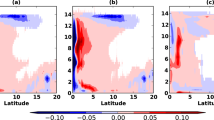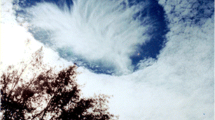Abstract
Modification of cloud microphysics and cloud albedo by cloud-active aerosol is generally identified and accepted, but the nature and magnitude of aerosol-cloud interactions are vaguely understood and thought to include a myriad of processes that vary regionally and confound the application of simple physical models of cloud-aerosol sensitivity. This paper presents observations demonstrating that cloud top stability through its regulation of mixing and vertical development is one of the critical mechanisms that regulate cloud response to cloud-active aerosol in some cloud systems. Strong above-cloud inversions are shown to buffer marine stratocumulus from the effects of mixing with drier, warmer inversion air. This buffering reduces the variability of the cloud liquid water path (LWP) and enables the clouds to remain nearly adiabatic. While weaker above-cloud inversions in continental stratocumulus promote variability in the LWP and sub-adiabatic LWPs, stronger inversions in marine stratocumulus enables a relatively adiabatic existence that increases the relationship of cloud microphysical alteration to cloud-active aerosol. This study has important implications for Geoengineering in that it demonstrates that cloud systems overlain by strong thermal inversions are more likely to respond predictably to intentional manipulation of the in-cloud concentration of cloud-active aerosol.
Similar content being viewed by others
References
Ackerman, A. S., M. P. Kirkpatrick, D. E. Stevens, and O. B. Toon, 2004: The impact of humidity above the stratiform clouds on indirect aerosol climate forcing. Nature, 432, 1014–1017.
Albrecht, B. A., 1989: Aerosols, cloud microphysics, and fractional cloudiness. Science, 245, 1227–1230.
—, C. W. Fairall, D. W. Thomson, and A. B. White, 1990: Surfacebased remote sensing of the observed and the adiabatic liquid water content of stratocumulus clouds. Geophys. Res. Lett., 17, 89–92.
Borg, L. A., and R. Bennartz, 2007: Vertical structure of stratiform marine boundary layer clouds and its impact on cloud albedo. Geophys. Res. Lett., 34, L05807, doi: 10.1029/ 2006GL02871389.
Chen, R., R. Wood, Z. Li, R. Ferraro, and F. L. Chang, 2008: Studying the vertical variation of cloud droplet effective radius using ship and spaceborne remote sensing data. J. Geophys. Res., 113, doi:10.1029/ 2007JD009596.
Clothiaux, E. E., T. P. Ackerman, G. G. Mace, K. P. Moran, R. T. Marchand, M. A. Miller, and B. E. Martner, 2000: Objective determination of cloud heights and radar reflectivities using a combination of active remote sensors at the ARM CART sites. J. Appl. Meteorol., 39, 645–665.
Feingold, G., W. Eberhard, D. E. Lane, and M. Previdi, 2003: First measurements of the Twomey effect using ground-based remote sensors. Geophys. Res. Lett., 1287, doi:10.1029/2002GL016633.
—, R. Furrer, P. Pelewskie, L. A. Remer, Q. Min, and H. Jonsson, 2006: Aerosol indirect effect studies at Southern Great Plains during the May 2003 intensive operational period. J. Geophys. Res., 111, doi:10.1029/2004JD005648.
Guo, H. Y. Liu, P. H. Daum, X. Zeng, X. Li, and W.-K. Tao, 2007: Investigation of the first and second aerosol indirect effects using data from the May 2003 Intensive Operational Period at the Southern Great Plains. J. Geophys. Res., 112, doi:10.1029,/2006/JD007173.
Hansen, J. E., and L. D. Travis, 1974: Light scattering in planetary atmospheres. Space Sci. Rev., 16, 527–610.
Intergovernmental Panel on Climate Change (IPCC), 2007: Climate Change 2007: The physical basis, Summary for Policymakers.
Kim, B.-G., S. E. Schwartz, M. A. Miller, and Q. Min, 2003: Effective radius of cloud droplets by ground-based remote sensing: Relationship to aerosol. J. Geophys. Res., 108, doi:10.1029 /2003JD003721.
—, S. A. Klein, and J. R. Norris, 2005: Continental liquid water cloud variability and its parameterization using ARM data. J. Geophys. Res., 110, doi:10.1029/2004JD005122.
—, M. A. Miller, S. E. Schwartz, Y. Liu, and Q. Min, 2008: The role of adiabaticity in the aerosol first indirect effect. J. Geophys. Res., 113, doi:10.1029/2007JD008961.
Klein, S. A., and D. L. Hartmann, 1993: The seasonal cycle of low stratiform clouds. J. Climate, 6, 1587–1606.
Latham, J., 1990: Control of global warming? Nature, 347, doi:10.1038/347339b0.
Lee, S. S., J. E. Penner, and S. M. Saleeby, 2009: Aerosol effects on liquidwater path of thin stratocumulus clouds. J. Geophys. Res., 114, doi:10.1029/2008JD010513.
Liljegren, J. C., E. E. Clothiaux, G. G. Mace, S. Kato, and X. Dong, 2001: A new retrieval for cloud liquid water path using a ground-based microwave radiometer and measurements of cloud temperature. J. Geophys. Res., 106, 14485–14500.
Liu, Y., P. H. Daum, and S. S. Yum, 2006: Analytical expression for the relative dispersion of the cloud droplet size distribution. Geophys. Res. Lett., 33, doi:10.1029/2005GL024502.
Lu, M.-L., and J. H. Seinfeld, 2005: Study of the aerosol indirect effect by large-eddy simulation of marine stratocumulus. J. Atmos. Sci., 62, 3909–3932.
—, G. Feingold, H. H. Jonsson, P. Y. Chuang, H. Gates, R. C. Flagan, and J. H. Seinfeld, 2008: Aerosol-cloud relationships in continental shallow cumulus. J. Geophys. Res., 113, doi:10.1029/2007JD009354.
Matsui, T., H. Masunaga, S. M. Kreidenweis, R. A. Pielke Sr., W.-K. Tao, M. Chin, and Y. J. Kaufman, 2006: Satellite-based assessment of marine low cloud variability associated with aerosol, atmospheric stability, and the diurnal cycle. J. Geophys. Res., 111, doi:10.1029/ 2005JD006097.
McComiskey, A., G. Feingold, A. S. Frisch, D. D. Turner, M. A. Miller, J. C. Chiu, Q. Min, and J. A. Ogren, 2009: An assessment of aerosolcloud interactions in marine stratus clouds based on surface remote sensing. J. Geophys. Res., 114, doi:10.1029/2008JD011006.
Min, Q., and L. C. Harrison, 1996: Cloud properties derived from surface MFRSR measurements and comparison with GOES results at the ARM SGP site. Geophys. Res. Lett., 23, 1641–1644.
—, —, and E. Clothiaux, 2001: Joint statistics of photon path length and cloud optical depth: case studies. J. Geophys. Res., 106, 7375–7386.
Shao, H., and G. Liu, 2009: A critical examination of the observed first aerosol indirect effect. J. Atmos. Sci., 66, 1018–1032.
Sheridan, P. J., D. J. Delene, and J. A. Ogren, 2001: Four year of continuous surface aerosol measurements from the Department of Energy’s Atmospheric Radiation Measurement program Southern Great Plains cloud and Radiation testbed site. J. Geophys. Res., 106, 20735–20747.
Sorooshian, A., G. Feingold, M. D. Lebsock, H. Jiang, and G. L. Stephens, 2010: Deconstructing the precipitation susceptibility construct: Improving methodology for aerosol-cloud precipitation studies. J. Geophys. Res., 115, doi:10.1029/2009JD013426.
Stephens, G. L., 1984: The parameterization of radiation for numerical weather prediction and climate models. Mon. Wea. Rev., 112, 826–967.
Stevens, B., and G. Feingold, 2009: Untangling aerosol effects on clouds and precipitation in a buffered system. Nature, 461, 607–613.
Twohy, C., M. D. Petters, J. R. Snider, B. Stevens, W. Tahnk, M. Wetzel, L. Russell, and F. Burnet, 2005: Evaluation of the aerosol indirect effect in marine stratocumulus clouds: droplet number, size, liquid water path, and radiative impact. J. Geophys. Res., 110, doi:10.1029/2004JD005116.
Twomey, S., 1974: Pollution and the planetary albedo. Atmos. Environ., 8, 1251–1256.
Wood, R., S. Irons, and P. R. Jonas, 2002: How important is the spectral ripening effect in stratiform boundary layer clouds? Studies using simple trajectory analysis. J. Atmos. Sci., 59, 2681–2693.
—, K. K. Comstock, C. S. Bretherton, C. Cornish, J. Tomlinson, D. R. Collins, and C. Fairall, 2008: Open cellular structure in marine stratocumulus sheets. J. Geophys. Res., 113, doi:10.1029/2007JD009371.
Author information
Authors and Affiliations
Corresponding author
Rights and permissions
About this article
Cite this article
Kim, YJ., Kim, BG., Miller, M. et al. Enhanced aerosol-cloud relationships in more stable and adiabatic clouds. Asia-Pacific J Atmos Sci 48, 283–293 (2012). https://doi.org/10.1007/s13143-012-0028-0
Received:
Revised:
Accepted:
Published:
Issue Date:
DOI: https://doi.org/10.1007/s13143-012-0028-0




